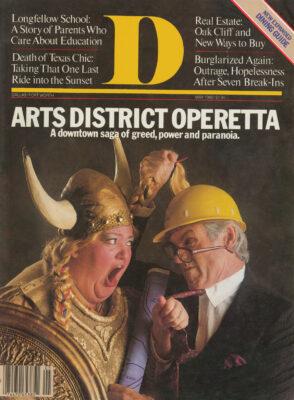“WE NEED religion for religion’s sake, morality for morality’s sake, art for art’s sake.” A French philosopher said that in 1818. The Dallas Symphony Association would like to add that we also need art to make a few bucks.
Specifically, we need an arts district, ana to have an arts district we need a new Concert Hall. And to have a new Concert Hall, we need to approve some $28 million in bonds this August 3 so the city can build the hall.
Concerned that the art-for-art’s-sake argument might go only so far with Dallas’ recession-pinched voters, the symphony , commissioned a study by a consulting group called LWFW, which found that art |is good business.
Take construction of the hall itself- lone of the smallest economic benefits – as an example. It will cost more than $40] million to build, and will stimulate SI33.8 | million worth of economic activity.
Operating the hall will bring about $7.9j million into Dallas’ economic system every year, with a ripple effect of $26.4 million annually in 1982 dollars.
when the new Rail opens l should allow the Dallas Symphony Orchestra to bring in an additional $1.3 million annually. And the Music Hall should bring in an extra $820,000 every year by scheduling more lucrative commercial events.
The arts district, chief consultant Don Reynolds says, should provide Dallasites with a stable, attractive downtown cultural area, encouraging construction of at least 500 luxury housing units in the area, while not influencing citywide construction rates.
Commercial development in and around the arts district should be substantially hastened by construction of the Concert Hall and the Museum of Fine Arts, LWFW says. It estimates that the 14 to 18 city blocks within the district can easily contain 10 million square feet of office and commercial space. That space almost certainly would be built whether there was an arts district or just a lot of vacant land, thanks to the district’s proximity to the expanding Central Business District. But Dallas is slipping into a construction slowdown as interest rates rise and the demand for office space falls. Without the arts facilities, LWFW says, at least 25 percent – and maybe 40 percent – of that space would be delayed for one building cycle, or at least five years.
Building costs are $100 per square foot or more, so at current tax rates a conservative estimate would be that without the district local governments would miss out on a total of $28.6 million in tax revenues over five years.
The LWFW report omits mention of another economic factor called “opportunity costs,” which refers to the difference between what some asset earns and what it might bring in ideally – if all “opportunities” were seized.
If a commercial building were erectetd on the symphony’s 88,000 square foot site, it would cost at least $130 million (compared to $40 million for the Concer Hall), with a “ripple effect” of $434.8 million (versus $133.8 million). Its operating costs – and their ripples-also would be correspondingly larger than the Concert Hall’s.
And, of course, the building would be taxable – to the tune of $2.98 million a year.
Reynolds says LWFW looked into such opportunity costs, but did not include them in its report because it realized that without the Concert Hall that block of land would be just another chunk of the downtown area.
“I talked to a guy who put this in perspective,” Reynolds says. “He told me, ’Why do we have streets downtown? We don’t make any [tax] money off them, but we have to have them.’ This is one of those things that you need for a good downtown. This is an amenity, like good streets, that attracts development.”
Get our weekly recap
Brings new meaning to the phrase Sunday Funday. No spam, ever.
Related Articles

Hockey
What We Saw, What It Felt Like: Stars-Golden Knights, Game 3
A close final score masks a dominant performance.
By Sean Shapiro and David Castillo

Basketball
What We Saw, What It Felt Like: Mavs-Clippers Game 3
Little brother no more.
By Iztok Franko and Mike Piellucci

Local News
In a Friday Shakeup, 97.1 The Freak Changes Formats and Fires Radio Legend Mike Rhyner
Two reports indicate the demise of The Freak and its free-flow talk format, and one of its most legendary voices confirmed he had been fired Friday.


